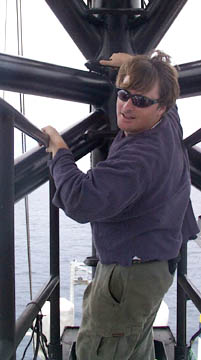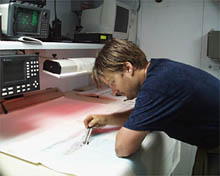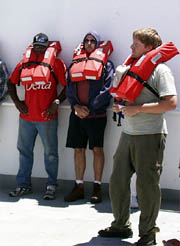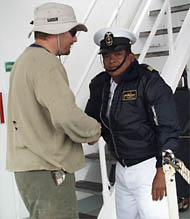|
|
Interviews: Chief Mate Eric Wakeman At 278 feet, the Melville needed to anchor at the deepest end of the Samoan harbor. Eric used one of the ship’s two smaller boats to travel between the ship and shore, about a 10-minute commute. Coral reefs outlining the bay protected the smaller boats from heavy ocean swells. Currents passing the mouth of the harbor brought nutrient rich water to the shallow marine life.
“I got the first bail of water in the jar. But, when I went to dump it out, I accidentally let go and the jar flew overboard.” He then tried to signal the ship. “I sent a flare out and accidentally shot it into the water instead of the air.” He started walking back and forth in the small 15-foot boat with more than a foot of water trying to figure out what to do next. “I was debating whether to jump or stay with it, the boat was so full of water it almost tipped over. I realized no one was aware of what was happening to me and if I was separated from the boat they may not find me, or I would get cut up on the coral reef or eaten by sharks.” That’s when he began to panic. “Strangely enough, I had just bought a pocket survival guide for all sorts of situations, but it didn’t include the situation I was in.”
Eric grew up skiing the slopes of Tahoe and the Sierra Nevadas a couple hours drive from his home near San Francisco. He is the oldest of three kids. In 1988, he joined the California Maritime Academy in Vallejo, Calif., for one reason: snow. “Someone told me a long time ago you could work for six months as a mariner and have six months free to ski in Switzerland. I have never skied in Switzerland. But I do have about four months on and two-and-a-half months off from work.” After four years of training, Eric was able to leapfrog to the position of Third Mate. “The purpose of the Marine Academy is to quickly get a Third Mate’s license, something that would take about 10 years of working at sea starting as an Ordinary Seaman.” It took Eric another year of inquiring about a job as a deck hand at Scripps, before they hired him. “They kept telling me deckies are a dime a dozen and then finally they were worth a quarter.”
Eric began working as Chief Mate on Revelle two months ago. “We have a talented and self-sufficient crew, so my responsibilities are actually pretty minimal,” he says. Eric monitors the routine maintenance of the ship; takes a leadership role during emergencies, fire and boat drills; and administers any first aid or medical attention if needed. In the evening, he takes his turn standing watch in the bridge. When asked his advice about a career as a mariner, Eric responds: “The marine industry comes and goes. Find something that you want to do and have as a job. I don’t think I could handle a daily job at shore, I have two commutes a year to and from the ship. My job is more a hobby I enjoy. Decide early what you want to do and have fun, and as someone once told me: ’do it while you’re young.’” As Eric would say: “Rodger Doger.” |
||||||||||
Mailing List | Feedback | Glossary | For Teachers | About Us | Contact
© 2010 Dive and Discover™. Dive and Discover™ is a registered trademark of
Woods
Hole Oceanographic Institution

 Eric climbs to the top of the communications mast.
Eric climbs to the top of the communications mast.

